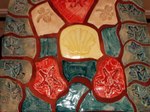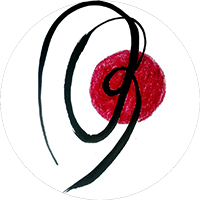 Hand-made tiles on recycled chair, Cottage by the Sea, detail, by Tammy Vitale of Tam’s Originals.
Hand-made tiles on recycled chair, Cottage by the Sea, detail, by Tammy Vitale of Tam’s Originals.
Do you have a definition for art? Or is it just that feeling you get when you look at something that someone (or even you) has made and you know you want it somewhere you can see it forever. Is art something that can be described or is it it’s own symbol, beyond words.
The 1,000 numbers phenomenon of this past week (see earlier posts) has gotten me thinking. And writing a bit of a rant today (June 4) over at myspace. I have been browsing and am going to share with you a bit of diverse ‘art." You decide if it should be called that. Let me know what you think.
Here is the home as art – not big architectural (read expensive) and professionally decorated, but art that extends "from their homemade furniture to their handpainted walls and brightly decorated entry stairways.
"’We’re not afraid of color," Matheney said about their Mexican-influenced style."
"Women’s" work: Quilting. The quilts of Gee’s Bend are on the move again, including newer work. I think I saw some of these quilts at the Renwick in DC years ago. The Gee’s Bend quilts were originally created by a group of women living in an isolated African-american hamlet, Gee’s Bend, Alabama. Alvia Wardlaw, curator, says "The compositions of these quilts contrast dramatically with the ordered regularity associated with many styles of Euro-american quiltmaking. There’s a brilliant, improvisational range of approaches to composition that is more often associated with the inventiveness and power of the leading 20th century abstract painters than it is with textile-making." See also: Artdaily.com.
I quilt. I have often thought of tile work as quilting in its own way. Made a quilt for Grandson using patterns from Daughter’s quilt (her ‘binky" and yes she still sleeps with it), patterns of my own, and material from family members: his dad’s jeans, his mom’s own quilt patch of teenage years extolling the New Kids on the Block, my own "magic blanket" – not a quilt, Poppy’s sweat shirt, Uncle’s tie-dyed sheet for backing, Paternal Grandma’s dress. Dog now sleeps in my room on a quilt pieced from all the blue jeans I embroidered in the 70s. That embroidery is going to even outlive this quilt, which I never really quilted. Quilting is what keeps it all together and from wearing. So this particular quilt is really wearing.
Browsed some of what’s out there and include it here in links for your enjoyment. Got $3K – $34K laying around? Check out the quilts at the Bryer Patch. Be sure to click on the images and view the quilting up close. ("Quilting" is actually the stitching that binds together the layers of pieced top, filling and backing on a quilt). Women’s work has come a long way – such a long way that you will find men taking it up now that it can be considered an art. Seems to me that BryerPatch’s work is a continuation on the themes introduced by the Gee’s Bend Women, more than traditional Euro-American quilting. And that impressionistic, abstractly designed quilt is THE thing in the quilt world today.
"’Crossing Boundaries‘ celebrates the emergence of the contemporary art quilt from an old and revered quilt tradition. It attests to the crossing of the boundary between old and new. Art quilts share a form with traditional quilts…However, when it comes to function, they part ways. The traditional quiltmaker intended her quilts to function as a decorative bedcover, while the contemporary quilt artist pushes the boundaries of quiltmaking by shifting the quilt from the bed to the gallery wall." Expanding Boundaries continues with that tradition."
Poetry: "Art’s relationship wtih life has always remained a subject of fierce contention among writers and ideologues. In India, the debates about art for art’s sake and ‘engaged’ literature animated the literary scene in the 1930s and 40s. The Progressive Writers’ Movement (PWM) that spearheaded this debate changed the complexion of literature in a couple of Indian languages, Urdu being the most prominent among them.
"Urdu poets had a dominant presence in the movement and the way they posited a radical aesthetics of resistance against oppressive hegemonies of all kinds had few parallels in South Asian literature. Some poems/couplets swept a generation of readers off their feet, making poetry the most potent weapon in the process of social transformation. [Italics mine].
"The authors argue that though PWM lost steam for a number of reasons, the spirit of resistance still survives, which is notably visible in the strand of feminist Urdu poetry in Pakistan. They see it as work in the poetry of a radical and fiercely independent band of women poets like Fahmida Riyaz, Kishwar Naheed, Parvin Shakir and others who have been waging a fierce battle against patriarchy and the fascist tendencies of the oppressive military regimes in Pakistan."
Hope you enjoy your Sunday reading.
Thought for the day: Okay, what IS Art? or art? How do you define it?



1 Comment
In my opinion quilts can obviously be art – and have been for many years.
Now whether or not the traditional art world views them as such and lets them into their precious galleries and museums is another question.